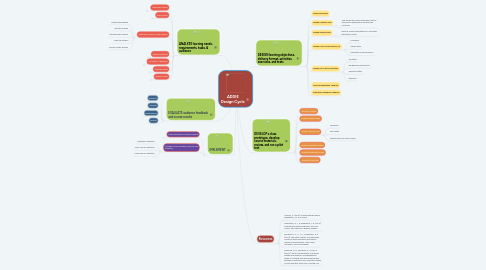
1. ANALYZE learning needs, requirements, tasks, & audience
1.1. Determine Needs
1.1.1. Is this a training issue?
1.1.2. Complete a Training Needs Analysis (TNA)
1.1.3. Identify constraints
1.2. Plan Project
1.2.1. How complex is the CONTENT?
1.2.2. How much DESIGN EXPERIENCE do the designers and SME's have?
1.2.3. How sophisticated is the DESIGN?
1.2.4. How much DOCUMENTATION is available?
1.2.5. Determine initial design time estimate
1.3. Interview Subject Matter Experts
1.3.1. Select interviewees
1.3.2. Plan the session
1.3.3. Introduce the session
1.3.4. Lead the session
1.3.5. Follow-up the session
1.4. Analyze Learners
1.4.1. How many?
1.4.2. Geographic location?
1.4.3. Education and experience?
1.4.4. Previous training & related skills?
1.4.5. Organizational level?
1.4.6. Physical factors?
1.4.7. Reading level and language?
1.4.8. Culture?
1.4.9. Any misconceptions?
1.4.10. Taboo topics?
1.4.11. Attitude toward class?
1.5. List Tasks/ "Chunking"
1.5.1. Action Verb + Noun (i.e. Facilitate role play)
1.5.2. Measurable
1.5.3. Brief
1.5.4. Each can be broken down into a series of steps
1.6. Prioritize Tasks
1.6.1. Frequency (FR)
1.6.2. Learning Difficulty (LD)
1.6.3. Importance to resolving GAP (IM)
1.6.4. Job Experience of learners (JE)
1.6.5. Priority in content of course (PR)
1.6.5.1. FR + LD + IM - (3xJE) = PR
1.7. Analyze Tasks
1.7.1. Steps are listed by breaking down each sub-task into detailed actions to be performed.
1.7.2. Each step is detailed enough so that learners could follow it without assistance.
1.7.3. Steps describe the standard for performing the task, identify any needed tools/ equipment, and target the bottom 25% of the class.
2. IMPLEMENT
2.1. Apply principles of Adult Learning
2.1.1. Maximize application of content
2.1.2. Increase attention span
2.1.3. Build group cohesiveness
2.1.4. Encourage healthy competition
2.1.5. Manage instructional time efficiently
2.1.6. Provide meaningful feedback
2.1.7. Attend to individual needs
2.1.8. Motivate learners
2.1.9. Encourage participation
2.1.10. Incorporate fun
2.1.11. Incorporate reviews and summaries
2.1.12. Manage group dynamics
2.1.13. Promote transfer of new skills on the job
2.2. Validate course content, process, and materials
2.2.1. Individual Validation
2.2.2. Small Group Validation
2.2.3. Large Group Validation
3. EVALUATE audience feedback and course results
3.1. Reaction
3.2. Learning
3.3. Performance
3.4. Results
4. DESIGN learning objectives, delivery format, activities, exercises, and tests
4.1. Write Objectives
4.2. Design Criterion Test
4.2.1. This will be the major application test or exercise to determine if learning has occurred.
4.3. Design Review Tests
4.3.1. Tests to review competency in sub-tasks during the course.
4.4. Design Post-Course Follow-Up
4.4.1. Coaching
4.4.2. Observation
4.4.3. Feedback on performance
4.5. Design Pre-Course Activities
4.5.1. Pre-tests
4.5.2. Background information
4.5.3. Welcome letter
4.5.4. Briefings
4.6. Select Presentation Methods
4.7. Determine Feedback Methods
5. DEVELOP a class prototype, develop course materials, review, and run a pilot test
5.1. Structure Course
5.2. Develop Lesson Plans
5.3. Create Learning Aids
5.3.1. Handouts
5.3.2. Flip Charts
5.3.3. PowerPoints and Multi-Media

